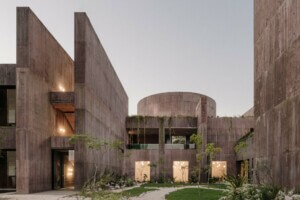It can be tough to keep up with the ever-evolving news at the intersection of architecture and technology. But fear not, dear readers—AN has you covered with a new-in-tech mini-roundup on the biohomes, metaverse house tours, and AI tastemaking to inform your practice and add to your “fun fact” cocktail hour conversation Rolodex:
University of Maine unveils first 3D home made from fully-recyclable, bio-based materials
Along with many other states and cities, Maine is facing an affordable housing crisis. 3D-printed homes, which often require less time and less labor to build on-site, may offer a solution to a challenging housing shortage. In that spirit, late last year researchers at the University of Maine Advanced Structures and Composites Center (ASCC) celebrated the completion of BioHome3D, the first 3D-printed home made with bio-based materials.
The 600-square-foot prototype’s 3D-printed roof is made of wood fibers and bio-resins, while the insulation is 100 percent wood material. The floors and walls are 3D-printed, as well. It was constructed from locally-sourced materials to reduce dependence on a global supply chain that’s weathered many shocks and crises since 2020.
BioHome3D was printed in four modules offsite; on-site assembly required only a half-day’s work.
“Many technologies are being developed to 3D print homes, but unlike BioHome3D, most are printed using concrete. However, only the concrete walls are printed on top of a conventionally cast concrete foundation. Traditional wood framing or wood trusses are used to complete the roof,” ASCC Executive Director Dr. Habib Dagher said in a press release. “Unlike the existing technologies, the entire BioHome3D was printed, including the floors, walls and roof. The biomaterials used are 100% recyclable, so our great-grandchildren can fully recycle BioHome3D.”
Future versions of the home could be customized to meet an owner’s space and energy needs. Right now, ASCC is monitoring the home’s performance through the bone-chilling Maine winter. These data will be used to inform BioHome3D’s future iterations.

Buildworld uses sentiment analysis tool to make list of world’s ugliest buildings
Using sentiment analysis tool HuggingFace, a team at building materials and products retailer Buildworld compiled a list of the world’s ugliest buildings. The team began with a list of buildings across the U.K. and U.S. often assumed to be “ugly” and ran the building names through HuggingFace, a machine learning platform trained to detect positive and negative tones about a topic or idea. The platform draws on tweets to analyze what is being said online about the buildings. The ugliest accolade is determined by, in this case, the percentage of negative sentiment on the building.
The machine has spoken and determined the worst eyesore to be the Scottish Parliament Building in Edinburgh, pictured above, a postmodern structure by architect Enric Miralles that had 42.07 percent of analyzed tweets critical of its design. Stateside, the J. Edgar Hoover Building a.k.a. the FBI Headquarters, was found to be the worst, with 37.84 percent of tweets criticizing its design. The Brutalist Boston City Hall building took second place. Chicago’s Thomson Center and the Watergate Complex also made it to the United States’ top ten list.
More information about the experiment and the full list of ugly buildings can be found here.
New discovery on the durable property of ancient Roman concrete
A research team from MIT, Harvard University, and laboratories in Italy and Switzerland has unearthed some secrets about a tried-and-true building material and method that’s just about as old as time: concrete. Their findings, which were published in the journal Science Advances earlier this month, provide evidence into the hearty material’s durability and self-healing nature.
It had been previously assumed that ancient concrete’s strength came from a pozzolanic material such as volcanic ash, but the discovery of “lime clasts,” tiny white minerals found in samples, is likely where the material gets its durability. Scientists had previously dismissed lime clasts as flecks left over from poor mixing technique, but now researchers are reviewing that conclusion.
Further study of the lime clasts determined they were made from calcium carbonate. A spectroscopic examination of the flecks led the team of researchers to deduce they were mixed into concrete at very hot temperatures and it is this process and step that solidifies concrete’s durability.
With this discovery, ancient buildings and statues with cracks can be repaired or made whole again, extending the life of structures and reducing the need for cement production which can have detrimental environmental impacts. It also opens the opportunity for new construction, namely 3D-printed buildings, which continue to rise in popularity as an alternative building material and method.
A national homebuilder is giving house tours in the metaverse
KB Home is inviting prospective clients to suit up an avatar and explore its model homes virtually. The homebuilding company created a showroom on the Decentraland platform for buyers to tour houses in contemporary, Spanish, farmhouse and craftsman styles. A virtual host is on hand to answer questions about the homes, the construction process, and customization options.
“KB Home has a long-standing history of groundbreaking innovation. Today, we’re creating opportunities with an eye toward the future, so next-gen homebuyers can experience a new KB Home community virtually,” KB Home Chairman, President and CEO Jeffrey Mezger said in a news release. “We know consumers are increasingly immersing themselves and spending more time in virtual spaces. KB Home’s metaverse community is all about discovery and creation and provides a captivating setting for homebuyers to explore what truly sets us apart – innovative design, personalization and partnership.”
The Los Angeles–based company partnered with The Metaverse Group to design and build out its Decentraland KB Home nirvana.

The UN makes protecting the ozone layer into an online game
This week the UN Environment Programme’s (UNEP) Ozone Secretariat launched its latest version of a simulator designed to help teens understand how to protect our precious, life-sustaining environments and ecosystems via global and local policy interventions.
The Apollo’s Edition of the Reset Earth Impact Simulator game allows students pick from four possible policy directions that impact the ozone layer. Apollo, a spunky, blue-haired avatar, pictured above, and her robot companion lay out the scenarios while educating students on the Montreal Protocol, the multilateral agreement that regulates ozone depleting substances (ODS).
“By giving young people innovative learning tools, we hope to inspire them to become the future scientists and policy-makers championing environmental protection,” said Meg Seki, Executive Secretary of the Ozone Secretariat.











